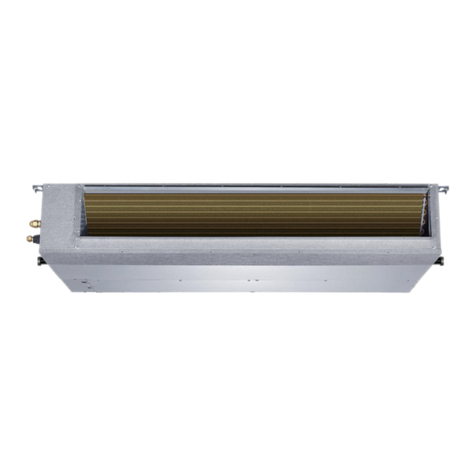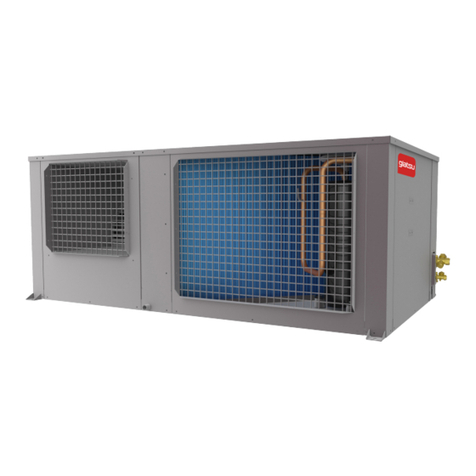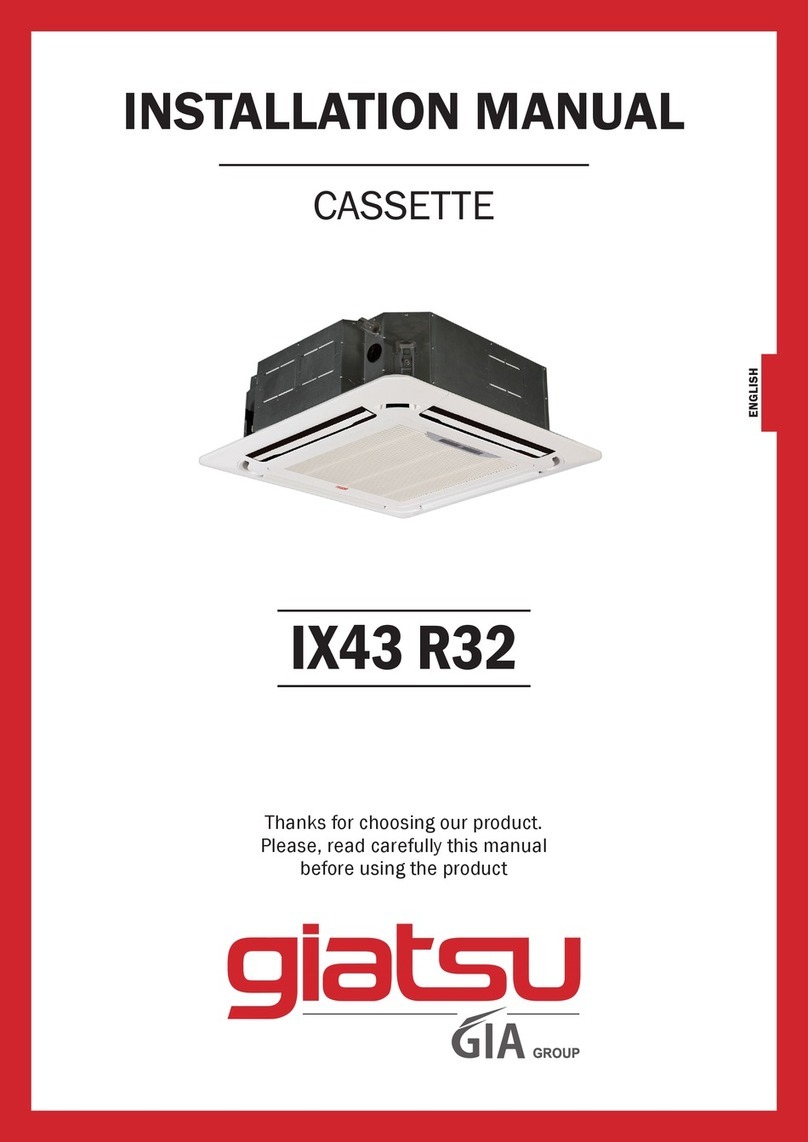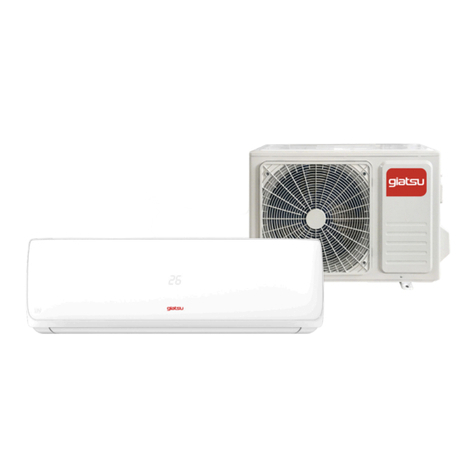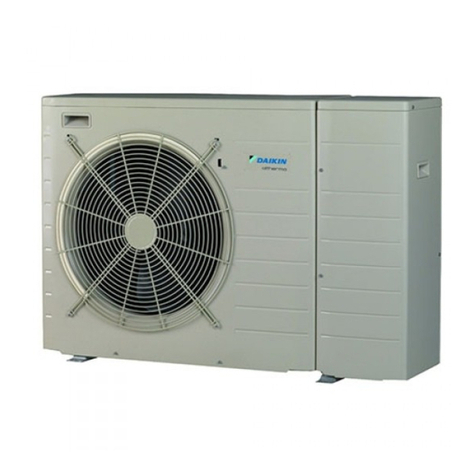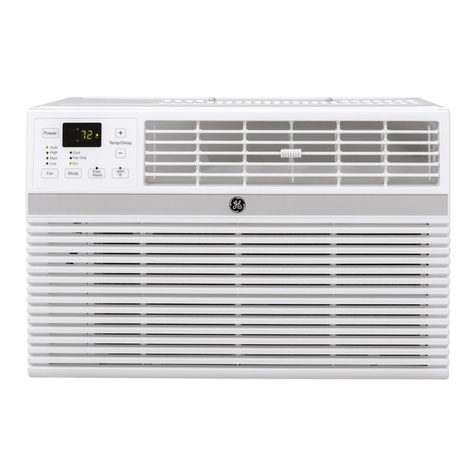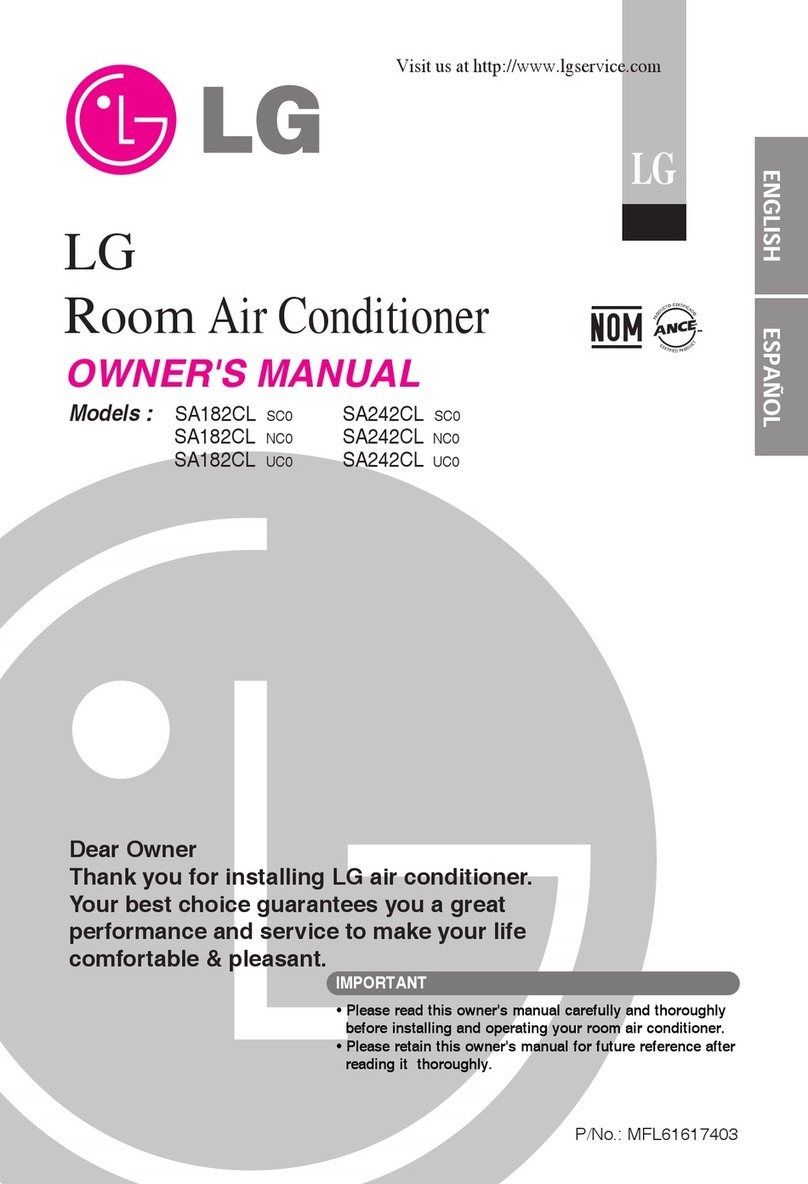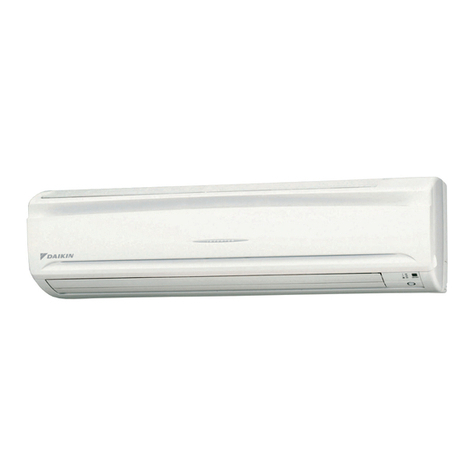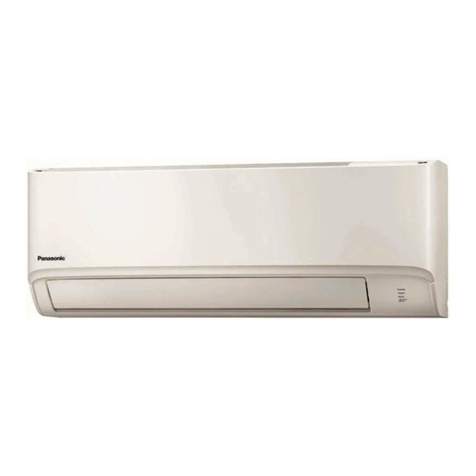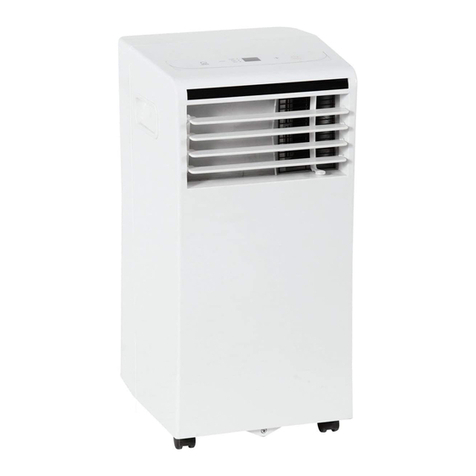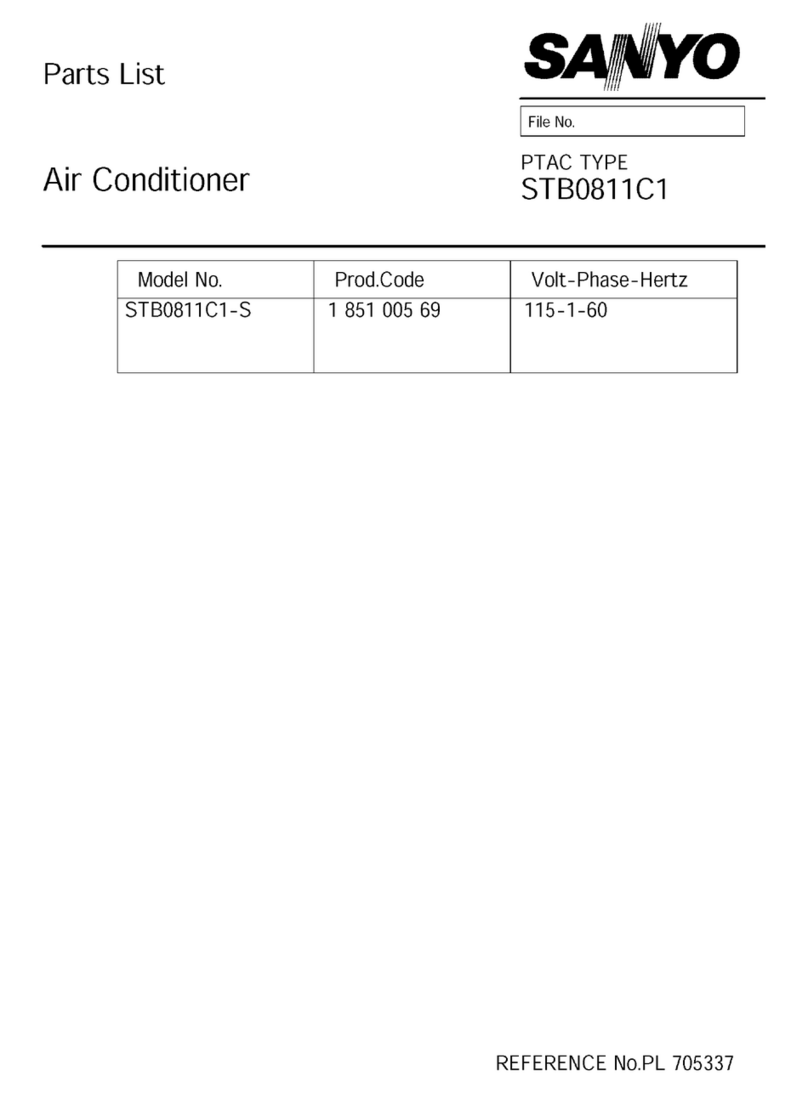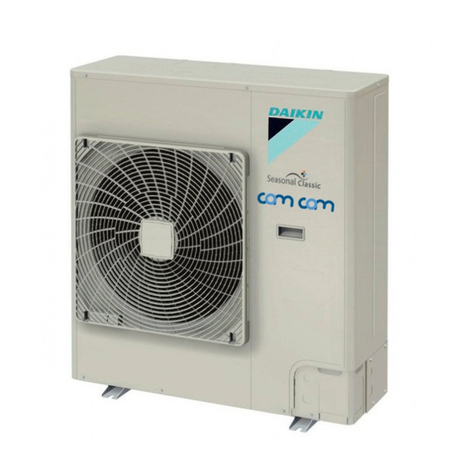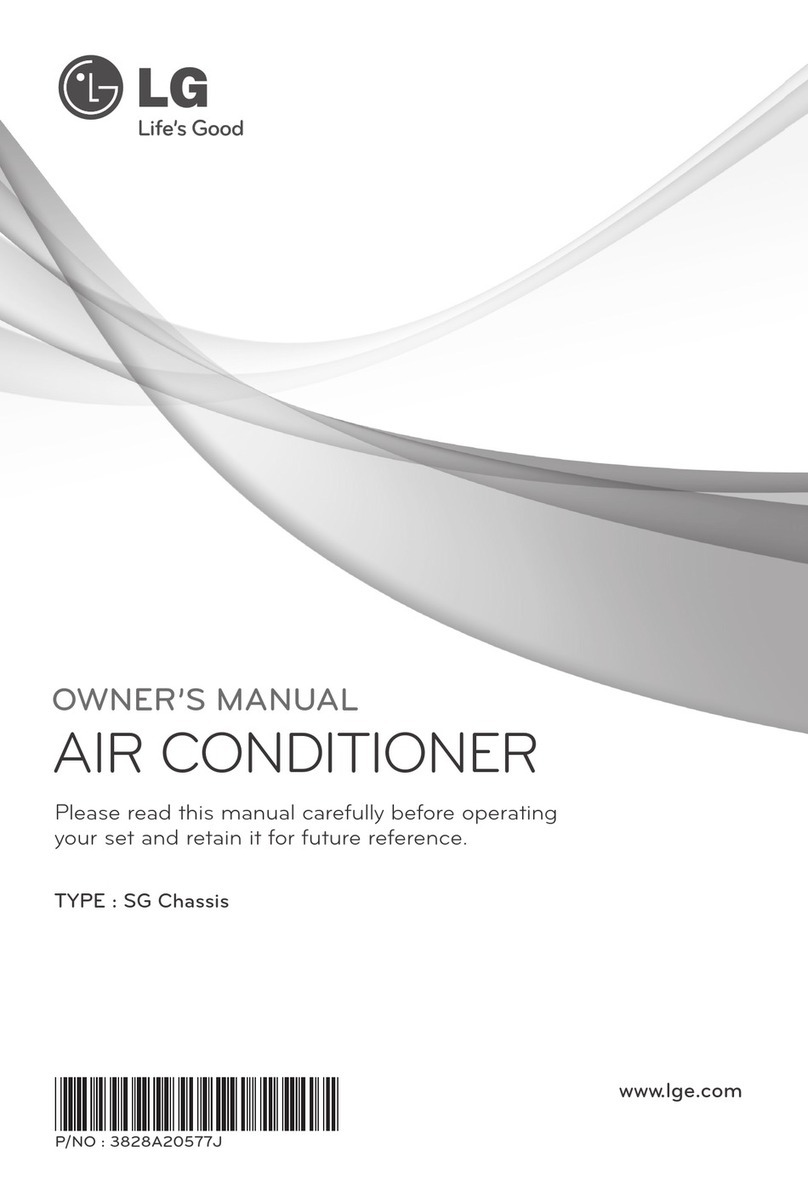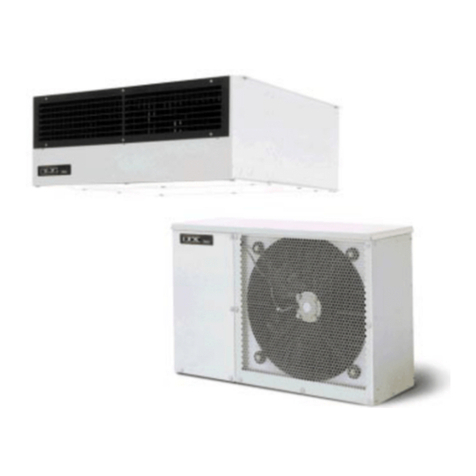Giatsu GIA-D-12IX43R32 User manual

IX43 R32
GIA-MDI-12IX43R32 |GIA-MDI-18IX43R32
GIA-D-12IX43R32 |GIA-D-18IX43R32
GIA-D-24IX43R32 |GIA-D-30IX43R32
GIA-D-36IX43R32 |GIA-D-42IX43R32
GIA-DT3-48IX43R32 |GIA-DT3-60IX43R32
Por favor lea atentamente este manual antes de usar este producto.
Please, read carefully this manual before using the product.
Avant d’utiliser l’équipement, lisez attentivement les instructions.
Por favor leia atentamente este manual antes de usar o equipamento.
Per favore leggere attentamente questo manuale prima di utilizzare questo prodotto.
DUCT
ES
EN
FR
PT
IT
INSTALLATION MANUAL
Gracias | Thank you | Merci | Obrigado | Grazie

IX43 R32
GIA-MDI-12IX43R32 |GIA-MDI-18IX43R32
GIA-D-12IX43R32 |GIA-D-18IX43R32
GIA-D-24IX43R32 |GIA-D-30IX43R32
GIA-D-36IX43R32 |GIA-D-42IX43R32
GIA-DT3-48IX43R32 |GIA-DT3-60IX43R32
ENGLISH
INSTALLATION MANUAL
DUCT

Accessories
....................................................
04
Indoor Unit Parts ........................................ 10
Indoor Unit Installation Instructions ....... 10
Safety Precautions
.....................................
09
Outdoor Unit Installation ......................... 15
Outdoor Unit Installation Instructions ...... 15
Outdoor Unit Types and Specifications .... 16
Notes on Drilling Hole in Wall .................... 17
Drainpipe Installation ............................... 18
Table of Contents
Installation Manual
Indoor Unit Installation ........................... 10
1
2
4
3
5
Indoor Unit Installation ........................... 07

(for R32/R290 refrigerant only )
Caution : Risk of fire
WARNING:
Servicing shall only be performed as recommended by the equipment
manufacturer.
Maintenance and repair requiring the assistance of other skilled
personnel shall be carried out under the supervision of the person
competent in the use of ammable refrigerants. For more details ,
please refer to the section of“ Information on servicing”.
(This is only required for the unit adopts R32/R290 Refrigerant).
Refrigerant Piping Connection....................... 20
Notes on Pipe Length and Elevation .............. 20
Refrigerant Piping Connection Instructions ...22
Wiring................................................. 25
Outdoor Unit Wiring .................. 25
Indoor Unit Wiring ..................... 26
Power Specifications ................... 28
Air Evacuation.................................................. 30
Evacuation Instructions ................................ 30
Note on Adding Refrigerant ....................... 31
Test Run.............................................................................. 32
6
7
8
9
L N
MC MC
European Disposal Guidelines .................... 33
10
Information Servicing ............................................. 34
11

Page 4
1
Safety Precautions
Read Safety Precautions Before Installation
Incorrect installation due to ignoring instructions can cause serious damage or injury.
The seriousness of potential damage or injuries is classified as either a WARNING or CAUTION.
WARNING
Failure to observe a warning may result in death. The appliance must be installed in
accordance with national regulations.
Failure to observe a caution may result in injury or equipment damage.
CAUTION
WARNING
1. Carefully read the Safety Precautions before installation.
2. In certain functional environments, such as kitchens, server rooms, etc., the use of
specially designed air-conditioning units is highly recommended.
3. Only trained and certied technicians should install, repair and service this air
conditioning unit.
4. Improper installation may result in electrical shock, short circuit, leaks, fire or other
damage to the equipment and personal property.
(In North America,installation must be performed in accordance with the requirement
of NEC and CEC by authorized personnel only.)
5. Strictly follow the installation instructions set forth in this manual.
6. Before you install the unit, consider strong winds, typhoons and earthquakes that might
aect your unit and locate it accordingly. Failure to do so could cause the equipment to
fail.
7. This appliance can be used by children aged from 8 years and above and persons with
reduced physical, sensory or mental capabilities or lack of experience and knowledge if
they have been given supervision or instruction concerning use of the appliance in a safe
way and understand the hazards involved. Children shall not play with the appliance.
Cleaning and user maintenance shall not be made by children without supervision.
(EN Standard requirements)
8. Do not use means to accelerate the defrosting process or to clean, other than those
recommended by the manufacturer.
9. This appliance is not intended for use by persons(including children) with reduced
physical, sensory or mental capabilities or lack of experience and knowledge, unless
they have been given supervision or instruction concerning use of the appliance by a
person responsible for their safety.(IEC Standard requirement )
10. Children should be supervised to ensure that they do not play with the appliance..
(IEC Standard requirement )
This symbol indicates that you must never perform the action indicated.

Page 5
WARNING
For units that have an auxiliary electric heater, do not install the unit within 1 meter (3 feet)
of any combustible materials.
Do not install the unit in a location that may be exposed to combustible gas leaks. If
combustible gas accumulates around the unit, it may cause re.
Do not
operate your air conditioner in a wet room such as a bathroom or laundry room. Too
much exposure to water can cause electrical components to short circuit.
1.
The product must be properly grounded at the time of installation, or electrical shock may occur.
2. Install drainage piping according to the instructions in this manual. Improper drainage may
cause water damage to your home and property.
CAUTION
11. If the supply cord is damaged, it must be replaced by the manufacturer,its service agent
or similarly qualied persons in order to avoid a hazard.
12. The appliance shall be installed in accordance with national wiring regulations.
13. An all-pole disconnection device which has at least 3mm clearances in all poles, and
have a leakage current that may exceed 10mA,the residual current device (RCD) having
a rated residual operating current not exceeding 30mA,and disconnection must be
incorporated in the xed wiring in accordance with the wiring rules.
14. The appliance disconnection must be incorporated with an all-pole disconnection
device in the xed wiring in accordance with the wiring rules.
15. Any person who is involved with working on or breaking into a refrigerant circuit
should hold a current valid certicate from an industry-accredited assessment authority,
which authorises their competence to handle refrigerants safely in accordance with an
industry recognised assessment specication.
16. Servicing shall only be performed as recommended by the equipment manufacturer.
17. Maintenance and repair requiring the assistance of other skilled personnel shall be
carried out under the supervision of the person competent in the use of ammable
refrigerants.
18. The appliance shall be stored so as to prevent mechanical damage from occurring.
19. Keep ventilation openings clear of obstruction.
20. Do not turn on the power until all work has been completed.
21. When moving or relocating the air conditioner, consult experienced service technicians
for disconnection and reinstallation of the unit
22. In certain functional environments, such as kitchens, server rooms, etc., the use of
specially designed air-conditioning units is highly recommended.
23. Removal of the plug has to be such that an operator can check from any of the points to
which he has access that the plug remains removed.
24. If this is not possible, due to the construction of the appliance or its installation, a
disconnection with a locking system in the isolated position shall be provided.
25. How to install the appliance to its support, please read the information for details in
"indoor unit installation" and "outdoor unit installation".

Page 6 Page 6
1.
Cautions for using R32/R290 refrigerant
Installation (Space)
- That the installation of pipe-work shall be kept to a minimum.
- That pipe-work shall be protected from physical damage.
- That compliance with national gas regulations shall be observed.
- That mechanical connections shall be accessible for maintenance purposes.
- In cases that require mechanical ventilation, ventilation openings shall be kept clear of
obstruction.
- When disposing of the product is used, be based on national regulations, properly processed.
-The appliance shall be stored in a well-ventilated area where the room size corresponds
to the room area as specied for operation.
-Spaces where refrigerant pipes shall be compliance with national gas regulations.
2. Servicing
- Any person who is involved with working on or breaking into a refrigerant circuit should
hold a current valid certicate from an industry-accredited assessment authority, which
authorises their competence to handle refrigerants safely in accordance with an industry
recognised assessment specication.
- Servicing shall only be performed as recommended by the equipment manufacturer.
Maintenance and repair requiring the assistance of other skilled personnel shall be carried
out under the supervision of the person competent in the use of ammable refrigerants.
Do not use means to accelerate the defrosting process or to clean, other than those
recommended by the manufacturer.
The appliance shall be stored in a room without continuously operating ignition sources
(for example: open ames,an operating gas appliance or an operating electric heater)
Do not pierce or burn.
Be aware that refrigerants may not contain an odour.
Be more careful that foreign matter(oil, water,etc) does not enter the piping. Also, when
storing the piping, securely seal the opening by pinching, taping, etc.
For indoor units, use R32 areless joint assy only when connecting the indoor unit and
connecting piping(when connecting indoors). Use of pipes, areless nut or are nuts other
than specied, may cause product malfunction, burst piping, or injury due to high internal
pressure of the refrigerant cycle caused by any inow air.
Appliance shall be installed, operated and stored in a room with a oor area larger than
X m² (Please see the following form ). The appliance shall not be installed in an
unventilated space, if that space is smaller than X m² (Please see the following form ).
3.
4.
5.
6.
7.
8.

Table.1-1
Table.1-2
Page 7
R32
Refrigerant
Type Installation
Height H0(m)
LFL(kg/m )
3Floor Area (m )
2
0.306
0.6
1.0
1.8
2.2
4
0.68
1.14
2.05
2.50
7
0.90
1.51
2.71
3.31
10
1.08
1.80
3.24
3.96
15
1.32
2.20
3.97
4.85
20
1.53
2.54
4.58
5.60
30
1.87
3.12
5.61
6.86
50
2.41
4.02
7.24
8.85
Max Refrigerant Charge (kg)
R32
LFL(kg/m )
3Charge Amount in kg
0.306
0.6
1.0
1.8
2.2
1.224 1.836
29
10
3
2
2.448
51
19
6
4
3.672
116
42
13
9
4.896
206
74
23
15
6.12
321
116
36
24
7.956
543
196
60
40
Min. Room Area (m )
2
Minimum Room Area ( m )
2
Refrigerant
Type Installation
Height H0(m)
Note about Fluorinated Gasses
1.
This air-conditioning unit contains fluorinated greenhouse gasses. For specic information
on the type of gas and the amount, please refer to the relevant label on the unit itself or the
“Owner's Manual - Product Fiche ” in the packaging of the outdoor unit. (European
Union products only).
2. Installation, service, maintenance and repair of this unit must be performed by a certified
technician.
3. Product uninstallation and recycling must be performed by a certified technician.
4. For equipment that contains uorinated greenhouse gases in quantities of 5 tonnes of CO
equivalent or more, but of less than 50 tonnes of CO equivalent, If the system has a leak-
detection system installed, it must be checked for leaks at least every 24 months.
2
2
5.
When the unit is checked for leaks, proper record-keeping of all checks is strongly
recommended.

Page 8
CAUTION
CAUTION
CAUTION
This symbol shows that a service personnel should be handling this
equipment with reference to the installation manual.
This symbol shows that information is available such as the operating
manual or installation manual.
This symbol shows that this appliance uses a ammable refrigerant. If the
refrigerant is leaked and exposed to an external ignition source, there is a
risk of re.
This symbol shows that the operation manual should be read carefully.
WARNING
CAUTION
Explanation of symbols displayed on the indoor unit or outdoor unia
(applicable to the unit adopts R32/R290 Refrigerant only):

Page 9
Accessories
Accessories
2
The air conditioning system comes with the following accessories. Use all of the installation parts
and accessories to install the air conditioner. Improper installation may result in water leakage,
electrical shock and re, or equipment failure.
Connecting wire for display (2m)
Cord protection rubber ring
QUANTITY
SHAPENAME
Soundproof / insulation sheath 2
1
1
2
Tubing & Fittings
Others
Installation manual
1
1
Owner‘s manual
Drain joint (some models)
Seal ring (some models)
Drainpipe Fittings
(for cooling & heating)
Seal sponge (some models)
EMC Magnetic Ring
(some models)
Magnetic ring
(wrap the electric wires S1 & S2 ( P & Q & E )
around the magnetic ring twice)
Magnetic ring
(Hitch on the connective cable between the indoor
unit and outdoor unit after installation.)
1
1
Orice (some models) 1
Transfer connector(Φ12.7-Φ15.9)/
( )(Packed with the indoor unit )
NOTE: Pipe size may dier from appliance to
appliance. To meet dierent pipe size requirements,
sometimes the pipe connections need a transfer
connector installed on the outdoor unit .
Φ0.5in-Φ0.63in
Transfer connector(Φ6.35-Φ9.52)/
( )(Packed with the indoor unit)
NOTE: Pipe size may dier from appliance to
appliance. To meet dierent pipe size requirements,
sometimes the pipe connections need a transfer
connector installed on the outdoor unit .
Φ0.25in-Φ0.375in
Transfer connector(Φ9.52-Φ12.7)/
( ) (Packed with the indoor unit,
used for multi-type models only )
NOTE: Pipe size may dier from appliance to
appliance. To meet dierent pipe size requirements,
sometimes the pipe connections need a transfer
connector installed on the outdoor unit .
Φ0.375in-Φ0.5in
1
(on some models)
1
(on some models)
1
(on some models)
1(on some models)
1(on some models)
1
Optional accessories
There are two types of remote controls: wired and wireless.
Select a remote controller based on customer preferences and requirements and install in an
appropriate place.
Refer to catalogues and technical literature for guidance on selecting a suitable remote controller.
•
S1&S2(P&Q&E)
Copper nut (some models)
NOTE:Used to make the connective pipes between
indoor and outdoor units.

Unit Installation
Indoor Unit
Installation
Page 10
Indoor Unit Installation 3
Indoor Unit Parts
Fig. 3.1
WARNING
•Securely install the indoor unit on a structure
that can sustain its weight. If the structure is
too weak, the unit may fall causing personal
injury, unit and property damage or death.
•
DO NOT install the indoor unit in the
bathroom or laundry room as excessive
moisture can short the unit and corrode the
wiring.
CAUTION
•Install the indoor and outdoor units, cables
and wires at least 1m (3.2’) from televisions
or radios to prevent static or image
distortion. Depending on the appliances, a
1m (3.2’) distance may not be sufficient.
•If the indoor unit is installed on a metal
part of the building, it must be electrically
grounded.
Indoor Unit Installation Instructions
Step 1: Select installation location
The indoor unit should be installed in a location
that meets the following requirements:
Enough room exists for installation and
maintenance.
Enough room exists for the connecting pipe
and drainpipe.
The ceiling is horizontal and its structure can
sustain the weight of the indoor unit.
The air inlet and outlet are not impeded.
The airflow can fill the entire room.
There is no direct radiation from heaters.
CAUTION
DO NOT install the unit in the following
locations:
In areas with oil drilling or fracking
In coastal areas with high salt content in
the air
In areas with caustic gases in the air, such
as near hot springs
In areas with power fluctuations, such as
factories
In enclosed spaces, such as cabinets
In kitchens that use natural gas
In areas with strong electromagnetic waves
In areas that store flammable materials or gas
In rooms with high humidity, such as
bathrooms or laundry rooms
Fig. 3.2
Air outlet
Air inlet
Air filter(on some models)
Drain hose
Electric control cabinet
Refrigerant connecting pipe
checking orice
60cmX60cm
30cm or more
20cm or more
Maintenance roomage
√
√
√
√
√
√
Safety Precautions
Models with a cooling capacity of 9000Btu to
18000Btu only apply to one room.
√

Page 11
Indoor Unit
Installation
Fig. 3.3
Step 2: Hang indoor unit.
1.
Please refer to the following diagrams to locate the four positioning screw bolt holes on the
ceiling. Be sure to mark the paces where you will drill ceiling hook holes.
Air outlet dimensions
Air inlet dimensions
Air lter
Descending ventilation opening and mounted hook
Air lter
Electric control box
Table.3-1 (unit: mm/inch)
MODEL
(Btu/h)
Outline dimension
A B C
18K 210/8.3 674/26.5880/34.6
24K 249/9.8 774/30.51100/43.3
30K~36K 249/9.8 774/30.51360/53.5
36K~60K 300/11.8 874/34.41200/47.2
air outlet opening size
D E F
136/5.4 706/27.8600/23.6
175/6.9 926/36.5700/27.6
175/6.9 1186/46.7700/27.6
227/8.9 1044/41.1800/31.5
air return opening size
190/7.5
228/8.9
228/8.9
280/11
Size of mounted lug
I
920/36.2782/30.8
1140/44.91001/39.4
1400/55.11261/49.6
1240/48.81101/43.3
J
G
H
508/20
598/23.5
598/23.5
697/27.4

Indoor Unit
Installation
Page 12
Cut o the roof beam.
Strengthen the point at which the cut was
made. Consolidate the roof beam.
Fig. 3.6
Fig. 3.7
Original concrete bricks
Use an embedding screw bolt, crock, and stick
harness. (See Fig.3.6)
Steel roof beam structure
Install and use the supporting steel angle.
(See Fig.3.7)
Fig. 3.4
Wood
Place the wood mounting across the roof beam,
then install the hanging screw bolts.(See Fig.3.4)
Wood mounting
Roof beam
Hanging screw bolts
Ceiling
Fig. 3.5
New concrete bricks
Inlay or embed the screw bolts. (See Fig. 3.5)
(Blade shape insertion) (Slide insertion)
Steel bar
Embedding screw bolt
(Pipe hanging and embedding screw bolt)
Hanging screw bolt
Hanging
bolts
Supporting
angle steel
Fig. 3.9
Screw nut
Washer
Hanging screw bolt
Overhang part
Shockproof cushion
NOTE:
Confirm the minimum drain tilt is
1/100 or more.
CAUTION
The unit body must be completely aligned
with the hole. Ensure that the unit and the
hole arethe same size before moving on.
2. Install and t pipes and wires after you have
nished installing the main body.When
choosing where to start, determine the
direction of the pipes to be drawn out.
Especially in cases where there is a ceiling
involved, align the refrigerant pipes, drain
pipes, and indoor and outdoor lines with their
connection points before mounting the unit.
3. Install hanging screw bolts.
4. After you select an installation location,align
the refrigerant pipes, drain pipes, as well as
indoor and outdoor wires with their
connection points before mounting the unit.
5. Drill 4 holes 10cm (4”) deep at the ceiling
hook positions in the internal ceiling. Be sure
to hold the drill at a 90° angle to the ceiling.
6. Secure the bolt using the washers and nuts
provided.
7. Install the four suspension bolts.
8. Mount the indoor unit with at least two
people to lift and secure it. Insert suspension
bolts into the unit’s hanging holes. Fasten
them using the washers and nuts provided.
(See Fig. 3.8).
9. Mount the indoor unit onto the hanging
screw bolts with a block. Position the indoor
unit at using a level indicator to prevent
leaks. (See Fig. 3.9).
Fig. 3.8

Indoor Unit
Installation
Page 13
Step 4: Adjust the air inlet direction
(From rear side to under-side.)
1. Take o the ventilation panel and ange.
2. Change the mounting positions of the
ventilation panel and air return ange.
Air return ange
Ventilation panel
3. When installing the lter mesh, t it into the
ange as illustrated in the following gure.
NOTE: All the gures in this manual are for
demonstration purposes only. The air
conditioner you have purchased may be
slightly dierent in design, though similar in
shape.
Fig. 3.11
Fig. 3.12
Fig. 3.13
Air return ange
Ventilation panel
Fig. 3.10
Step 3: Duct and accessories installation
NOTE:
1. Do not place the connecting duct weight on
the indoor unit.
2.When connecting the duct, use an
nonammable canvas tie-in to prevent
vibrating.
3.Insulation foam must be wrapped outside
the duct to avoid condensate. An internal
duct underlayer can be added to reduce
noise, if the end-user requires.
1. Install the lter (optional) according to the size
of the air inlet.
5. Refer to the following static pressure guidelines
when installing the indoor unit.
Change the fan motor static pressure
according to external duct static pressure.
2. Install the canvas tie-in between the body and
duct.
3. The air inlet and air outlet duct should be far
enough apart enough to a avoid air passage
short-circuit.
4. Connect the duct according to the following
diagram:
Canvas tie-in Canvas tie-in
Air outlet Isolation booth
Isolation booth
checking orice
Air inlet
Air dust lter
Table.3-2
Static Pressure
(Pa)
MODEL
(Btu/h)
18K
24K
30K~36K
36K~60K
0~100
0~160
0~160
0~160

Page 14
Indoor Unit
Installation
Step 5: Fresh air duct installation
Dimension : Duct joint for fresh air
Ø125mm(4.92”) Ø160mm(6.3”)
MODLE
18-60
Step 6: Motor and drain pump maintenance
Motor maintenance:
Take o the ventilated panel.
Take o the blower housing.
Take o the motor.
1.
2.
3.
(the rear ventilated panel is used as an example)
Pump maintainance:
Remove four screws from the drain pump.
Unplug the pump power supply and water
level switch cable.
Detach the pump.
1.
2.
3.
Pump
Fig. 3.14
Fig. 3.15
Fig. 3.16
Motor
Blower housing
Ventilated panel

Page 15
Outdoor Unit
Installation
Outdoor Unit Installation
Outdoor Unit Installation Instructions
Step 1: Select installation location.
The outdoor unit should be installed in the
location that meets the following requirements:
Place the outdoor unit as close to the indoor
unit as possible.
Ensure that there is enough room for
installation and maintenance.
The air inlet and outlet must not be
obstructed or exposed to strong wind.
Ensure the location of the unit will not be
subject to snowdrifts, accumulation of leaves
or other seasonal debris. If possible, provide
an awning for the unit. Ensure the awning
does not obstruct airflow.
The installation area must be dry and well
ventilated.
There must be enough room to install the
connecting pipes and cables and to access
them for maintenance.
The area must be free of combustible gases
and chemicals.
The pipe length between the outdoor and
indoor unit may not exceed the maximum
allowable pipe length.
If possible, DO NOT install the unit where it
is exposed to direct sunlight.
If possible, make sure the unit is located far
away from your neighbors’ property so that
the noise from the unit will not disturb them.
If the location is exposed to strong winds (for
example: near a seaside), the unit must be
placed against the wall to shelter it from the
wind. If necessary, use an awning.
(See Fig. 4.1 & 4.2)
Install the indoor and outdoor units, cables
and wires at least 1 meter from televisions or
radios to prevent static or image distortion.
Depending on the radio waves, a 1 meter
distance may not be enough to eliminate all
interference.
Strong wind
Strong wind
Strong wind
Fig. 4.1 Fig. 4.2
Step 2: Install outdoor unit.
Fix the outdoor unit with anchor bolts (M10)
>60cm / 23.6”
Fix with bolts
CAUTION
• Be sure to remove any obstacles that
may block air circulation.
• Make sure you refer to Length
Specifications to ensure there is
enough room for installation and
maintenance.
Fig. 4.3
4
√
√
√
√
√
√
√
√
√
√
√
√

Outdoor Unit
Outdoor Unit
Installation
Page 16
Air Outlet
(Wall or obstacle)
H
D
W
Air inlet
Air inlet Air inlet
Air inlet
(Wall or obstacle)
Table 4.1: Length Specifications of Split
Type Outdoor Unit (unit: mm/inch)
Table 4.2: Length Specifications of Vertical
Discharge Outdoor Unit (unit: mm/inch)
MODEL
DIMENSIONS
W H D
18 633/25 554/21.8554/21.8
24 633/25 554/21.8554/21.8
36 759/29.8 554/21.8554/21.8
36 633/25 600/23.6600/23.6
48 759/29.8 710/28710/28
60 843/33 710/28710/28
Split Type Outdoor Unit
(Refer to Fig 4.4, 4.5, 4.6, 4.10 and Table 4.1)
Vertical Discharge Type Outdoor Unit
(Refer to Fig 4.7, 4.8, 4.9 and Table 4.2)
Fig. 4.7
Fig. 4.8
Fig. 4.9
Fig. 4.6
Fig. 4.5
A
B
D
Fig. 4.4
Outdoor Unit Dimensions
W x H x D
Mounting Dimensions
Distance A Distance B
760x590x285 (29.9x23.2x11.2) 530 (20.85) 290 (11.4)
810x558x310 (31.9x22x12.2) 549 (21.6) 325 (12.8)
845x700x320 (33.27x27.5x12.6) 560 (22) 335 (13.2)
900x860x315 (35.4x33.85x12.4) 590 (23.2) 333 (13.1)
945x810x395 (37.2x31.9x15.55) 640 (25.2) 405 (15.95)
990x965x345 (38.98x38x13.58) 624 (24.58) 366 (14.4)
946x810x420 (37.24x31.9x16.53) 673 (26.5) 403 (15.87)
946x810x410 (37.24x31.9x16.14) 673 (26.5) 403 (15.87)
952x1333x410 (37.5x52.5x16.14) 634 (24.96) 404 (15.9)
952x1333x415 (37.5x52.5x16.34) 634 (24.96) 404 (15.9)
845x702x363 (33.27x27.6x14.3) 540 (21.26) 350 (13.8)
938x1369x392 (36.93x53.9x15.43) 634 (24.96) 404 (15.9)
900x1170x350 (35.4x46x13.8) 590 (23.2) 378 (14.88)
800x554x333 (31.5x21.8x13.1) 514 (20.24) 340 (13.39)
>152.4cm / 60”
>45.7cm / 18” >45.7cm / 18”
>45.7cm / 18”
>45.7cm / 18”
W
H
W
H
Outdoor Unit Types and Specifications

M
N
P
30 cm / 11.8” from back wall
60 cm / 23.6” on right
60 cm / 23.6” above
30 cm / 11.8” on left
200 cm / 78” in front
Outdoor Unit
Installation
Page 17
NOTE: The minimum distance between the
outdoor unit and walls described in the
installation guide does not apply to airtight
rooms. Be sure to keep the unit
unobstructed in at least two of the three
directions (M, N, P) . (See Fig. 4.10)
Fig. 4.10
Fig. 4.11
NOTE: Make sure the water drains to a safe
location where it will not cause water
damage or a slipping hazard.
Seal
Drain joint
(A) (B)
Base pan hole of
outdoor unit
Seal
Fig. 4.12
Notes On Drilling Hole In Wall
You must drill a hole in the wall for the
refrigerant piping, and the signal cable that will
connect the indoor and outdoor units.
1. Determine the location of the wall hole
based on the location of the outdoor unit.
2. Using a 65-mm (2.5”) core drill, drill a hole
in the wall.
NOTE: When drilling the wall hole, make
sure to avoid wires, plumbing, and other
sensitive components.
3. Place the protective wall cu in the hole.
This protects the edges of the hole and will
help seal it when you nish the installation
process.
Fig. 5.11
L
H
300 cm / 118” or more
A
60 cm / 23.6”
or more
150 cm / 59”
or more
25 cm / 9.8”
or more
25 cm / 9.8”
or more
Rows of series installation
L ≤H L ≤1/2H
L A
25 cm / 9.8” or more
1/2H < L ≤H
30 cm / 11.8” or more
L >H Can not be installed
Table 4.3 The relations between H, A and L
are as follows.
Drain Joint Installation
If the drain joint comes with a rubber seal
(see Fig. 4.12 - A ), do the following:
1. Fit the rubber seal on the end of the drain joint
that will connect to the outdoor unit.
2. Insert the drain joint into the hole in the base
pan of the unit.
3. Rotate the drain joint 90° until it clicks in place
facing the front of the unit.
4. Connect a drain hose extension (not included)
to the drain joint to redirect water from the
unit during heating mode.
If the drain joint doesn’t come with a rubber
seal (see Fig. 4.12 - B ), do the following:
Insert the drain joint into the hole in the base
pan of the unit. The drain joint will click in
place.
Connect a drain hose extension (not included)
to the drain joint to redirect water from the
unit during heating mode.

Drainpipe
Installation
Page 18
Fig. 5.3
(39-59”)
(7.9”)
<20cm
(21.7”)
<55cm
Lean over 1/50
1-1.5m1-1
Drainpipe installation for units with a pump
Ceiling
0 - 75mm
(3”)
NOTE ON DRAINPIPE INSTALLATION
• When using an extended drainpipe,
tightenthe indoor connection with an
additionalprotection tube. This prevents
it from pulling loose.
•
The drainpipe should slope downward at a
gradient of at least 1/100 to prevent water
from flowing back into the air conditioner.
• To prevent the pipe from sagging, space
hanging wires every 1-1.5m (39-59”).
• If the outlet of the drainpipe is higher than
the body’s pump joint, use a lift pipe for
the indoor unit’s exhaust outlet. The lift
pipe must be installed no higher than
55cm (21.7”) from the ceiling board. The
distance between the unit and the lift pipe
must be less than 20cm (7.9”). Incorrect
installation could cause water to ow back
into the unit and ood.
The drainpipe is used to drain water away from
the unit. Improper installation may cause unit
and property damage.
CAUTION
• Insulate all piping to prevent condensation,
which could lead to water damage.
• If the drainpipe is bent or installed
incorrectly, water may leak and cause a
water-level switch malfunction.
• In HEAT mode, the outdoor unit will
discharge water. Ensure that the drain hose
is placed in an appropriate area to avoid
water damage and slippage.
• DO NOT pull the drainpipe forcefully. This
could disconnect it.
NOTE ON PURCHASING PIPES
This installation requires a polyethylene tube
(outside diameter = 3.7-3.9cm, inside diameter
= 3.2cm), which can be obtained at your local
hardware store or dealer.
Indoor Drainpipe Installation
Install the drainpipe as illustrated in Fig5.2.
1.
2.
Drainpipe
connecting port
Drain hose
Pipe clasp Insulation
Fig. 5.1
Drainpipe Installation
Fig. 5.2
5
Cover the drainpipe with heat insulation to
prevent condensation and leakage.
Attach the mouth of the drain hose to the
unit’s outlet pipe. Sheath the mouth of the
hose and clip it rmly with a pipe clasp.
(Fig 5.1)
NOTE: When connecting multiple drainpipes,
install the pipes as illustrated in Fig 5.4.
(39-59”)
1-1.5m1-1
Lean over 1/50
Ceiling
• To prevent air bubbles, keep the drain
hose level or slightly tiled up (<75mm / 3”).
0-53cm
(20.8”)
≥10cm
(4”)
Fig. 5.4

Drainpipe
Installation
Page 19
Drainage test
Check whether the drainpipe is unhindered.
This test should be performed on newly built
houses before the ceiling is paved.
Units with a pump.
Units without a pump.
1. Remove the test cover.
Fill the water pan with 2 liters of water.
2. Turn on the unit in COOLING mode. You will
hear the drain pump.Check whether the
water is discharged properly (a 1-minute lag
is possible, depending on the length of the
drain pipe), Check whether water leaks from
the joints.
3. Turn o the air conditioner and put the cap
back on.
3. Using a 65-mm (2.5”) core drill, drill a hole in
the wall. Make sure that the hole is drilled at
a slight downward angle, so that the outdoor
end of the hole is lower than the indoor end
by about 12mm (0.5”). This will ensure proper
water drainage (See Fig. 5.5). Place the
protective wall cu in the hole. This protects
the edges of the hole and will help seal it
once you nish installation.
Wall
IndoorOutdoor
≈ 12mm / 0.5 inch
Fig. 5.5
NOTE: When drilling the hole, make sure to
avoid wires, plumbing, and other sensitive
components.
4. Pass the drain hose through the wall hole.
Make sure the water drains to a safe location
where it will not cause water damage or a
slipping hazard.
NOTE: The drainpipe outlet should be at least
5cm (1.9”) above the ground. If it touches the
ground, the unit may become blocked and
malfunction. If you discharge the water directly
into a sewer, make sure that the drain has a U
or S pipe to catch odors that might otherwise
come back into the house.
Test cap Fig.5.7
Fig.5.8
C
L
O
S
E
D
O
P
E
N
C
L
O
S
E
D
O
P
E
N
Stow tube
Fig.5.6
Stow tube
Fill the water pan with 2 liters of water.
Check that the drainpipe is unhindered.
This manual suits for next models
10
Table of contents
Other Giatsu Air Conditioner manuals
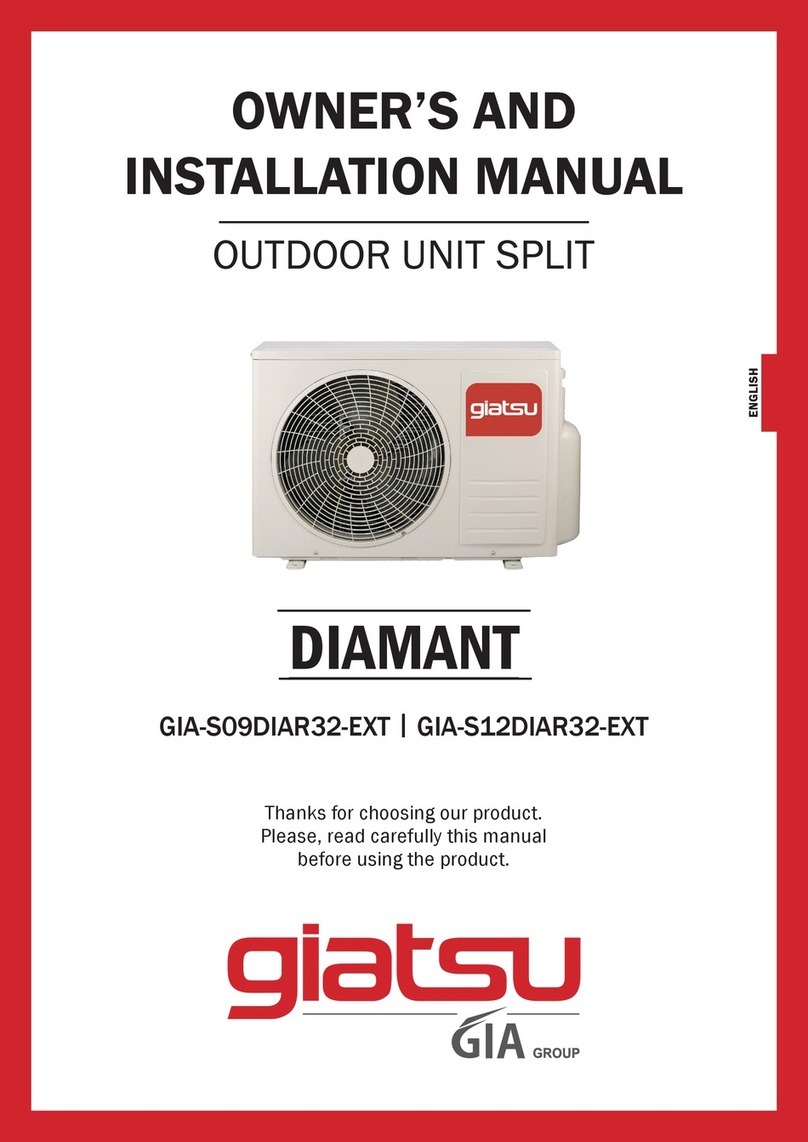
Giatsu
Giatsu DIAMANT GIA-S09DIAR32-EXT Service manual
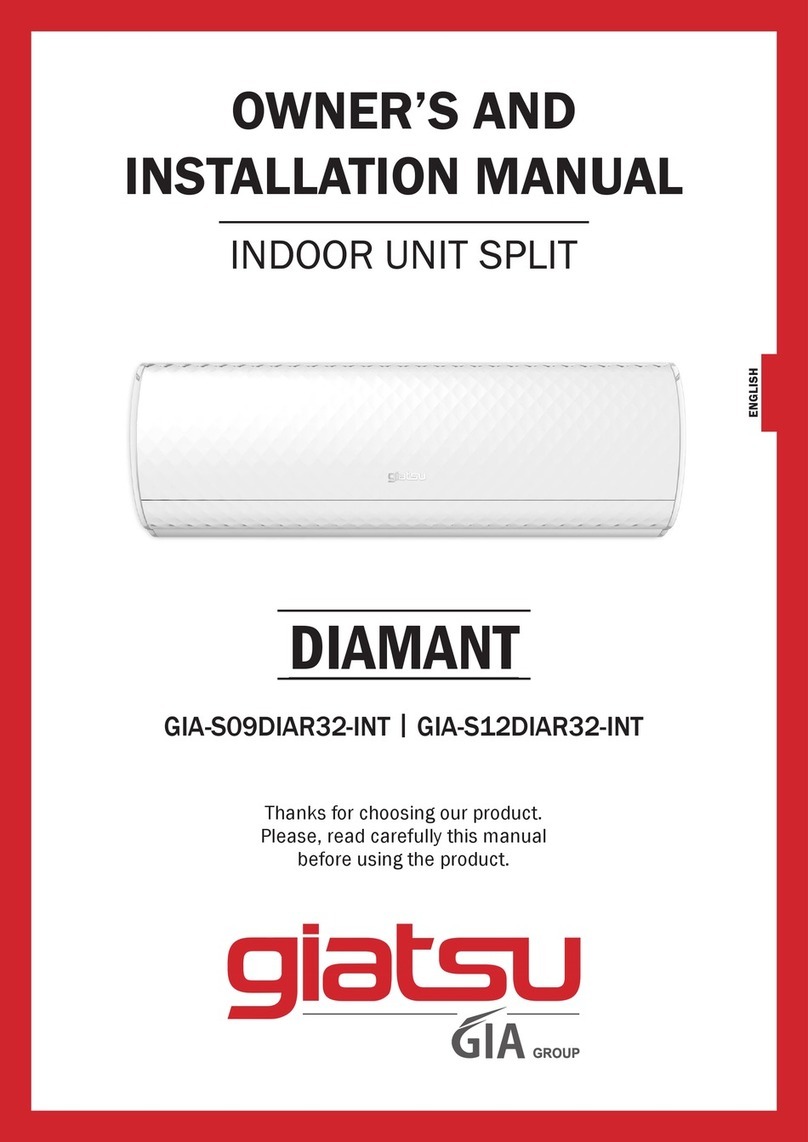
Giatsu
Giatsu DIAMANT GIA-S09DIAR32-INT Service manual

Giatsu
Giatsu MAMBA Service manual
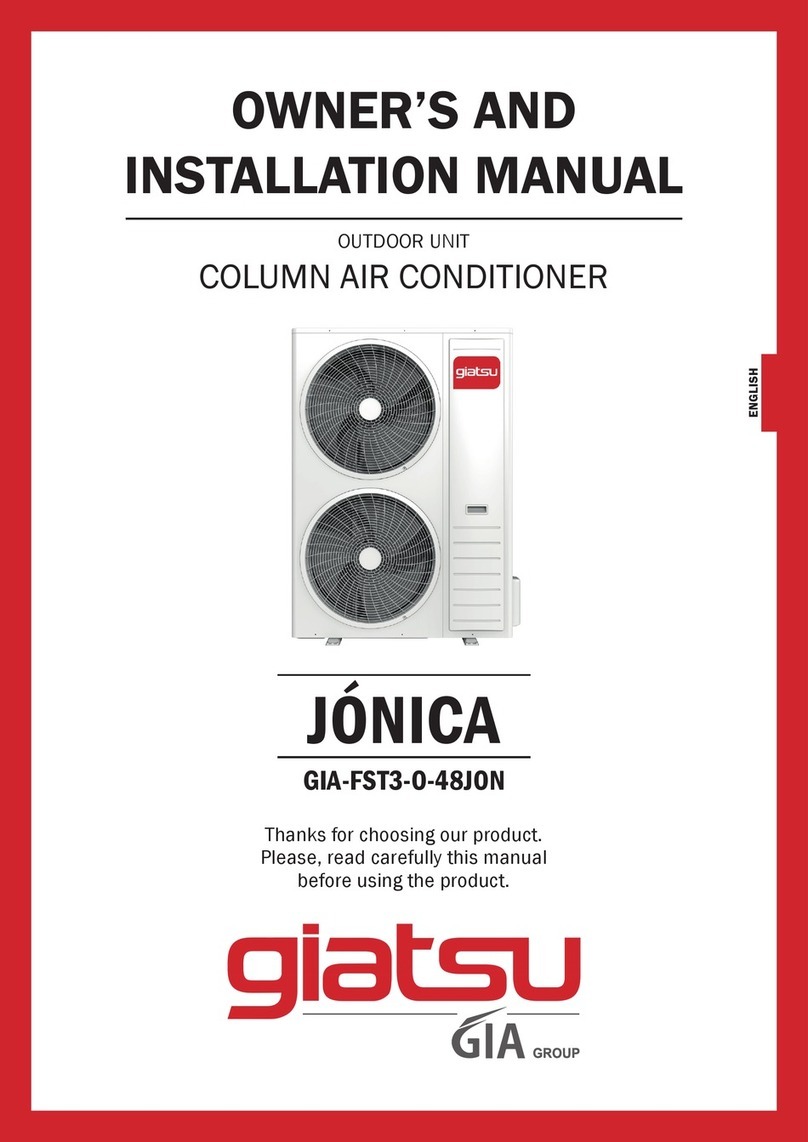
Giatsu
Giatsu JONICA GIA-FST3-O-48JON Service manual
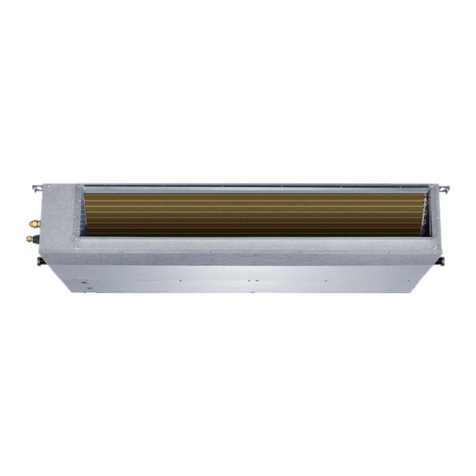
Giatsu
Giatsu GIA-MDI-12IX43R32 User manual
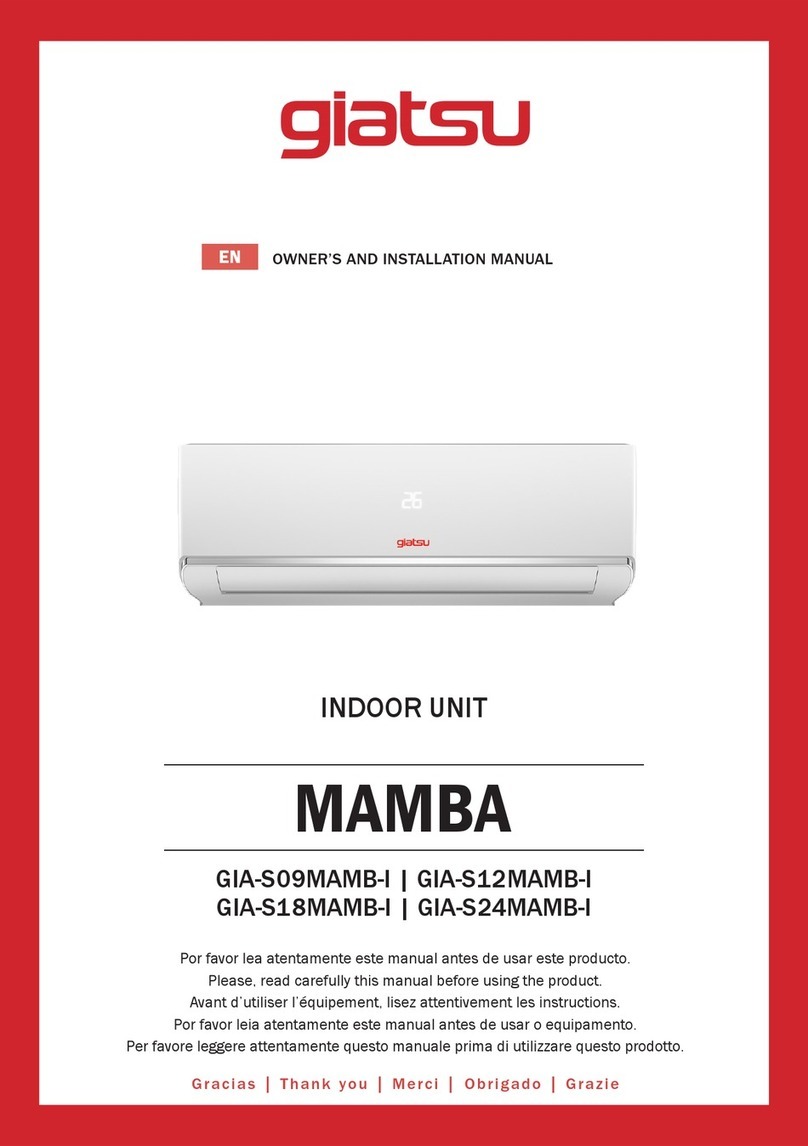
Giatsu
Giatsu MAMBA GIA-S09MAMB-I Service manual

Giatsu
Giatsu PREMIUM R32 Service manual
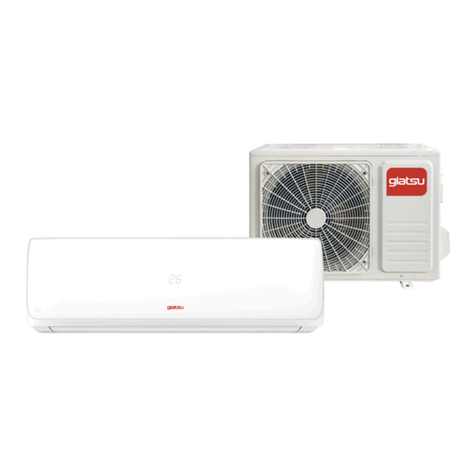
Giatsu
Giatsu VIOLET UV GIA-S12VIOUV User manual
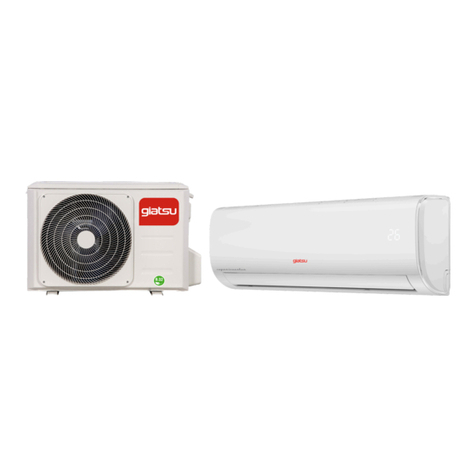
Giatsu
Giatsu GIA-S09AR2B-R32 User manual
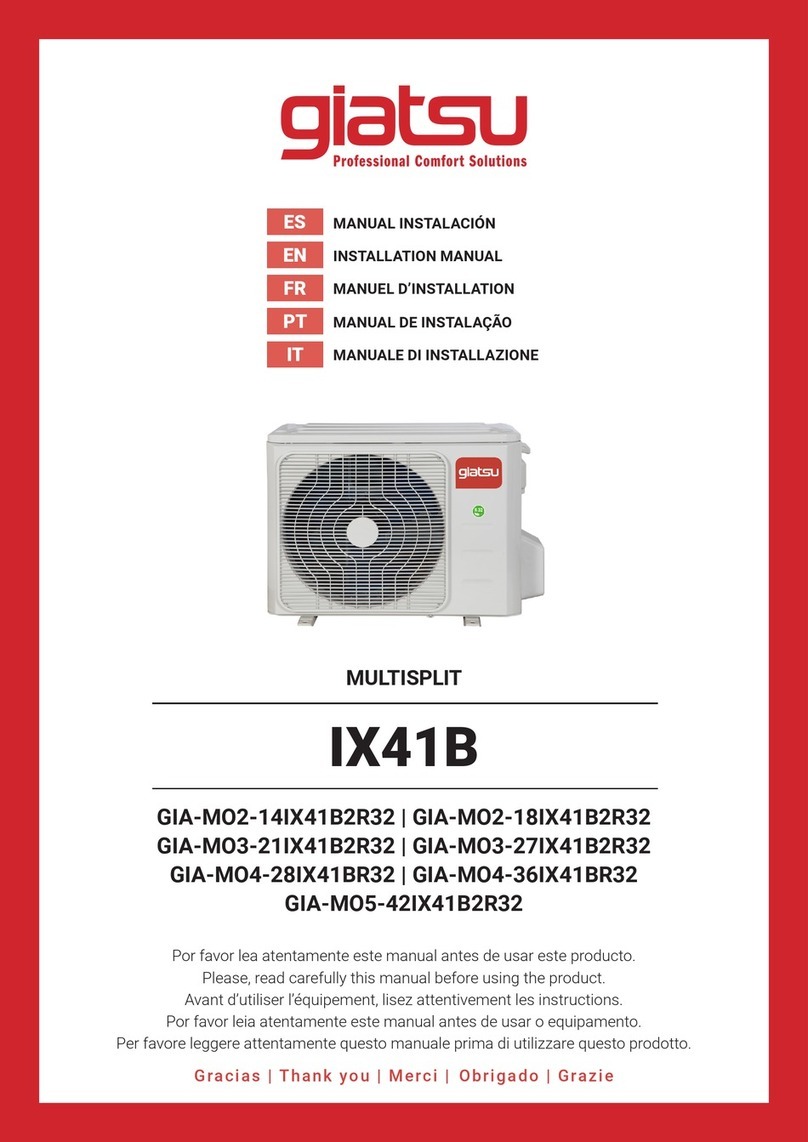
Giatsu
Giatsu IX41B Series User manual
